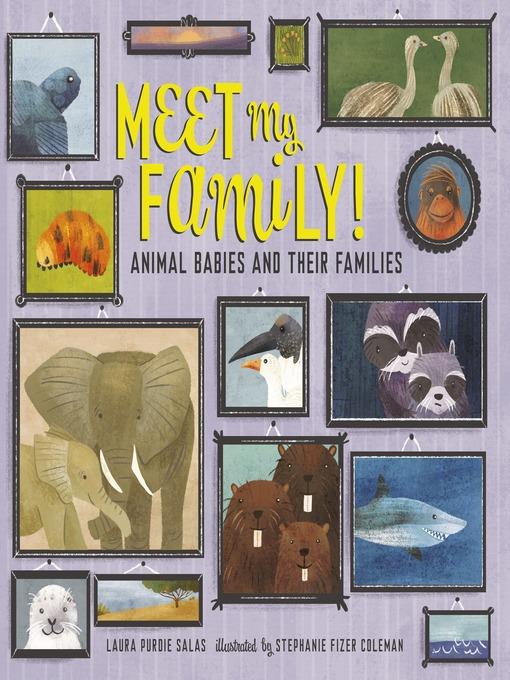
Meet My Family!
Animal Babies and Their Families
فرمت کتاب
ebook
تاریخ انتشار
2018
Lexile Score
550
Reading Level
0-2
ATOS
2.9
Interest Level
K-3(LG)
نویسنده
Stephanie Fizer Colemanشابک
9781512498639
کتاب های مرتبط
- اطلاعات
- نقد و بررسی
- دیدگاه کاربران
نقد و بررسی

January 22, 2018
In a tender celebration of family, more than 20 baby animals describe the ways the adults in their lives care for them. A baby beaver has lived in one home for all of its life, but an orangutan infant gets a new nest each night: “I never know where I’ll be, but I always know she’ll be right beside me.” Coleman shows the animal families interacting in sunny, collage-like digital illustrations, emphasizing different habitats through variations in color and texture. Salas also makes some allusions to nontraditional human families: “Two dads are what I’ve got!” says a penguin chick; “I’ve never met my dad,” states a raccoon kit. In a fitting conclusion, a final spread shows groupings of four human families, including single parents, a Muslim family, and two mothers with their children. Ages 5–9.

December 1, 2017
Gr 2-4-What would it be like to be an animal baby? With just the right dose of information and bright, sweetly imagined full-page scenes, this book introduces children to the fact that family compositions, appearances, life cycles, eating habits, behaviors, and modes of play all vary greatly among living beings. Some animals are given their own spread. Others are paired with another creature, such as the North American River Otter pup and the Green Sea Turtle hatchling, where contrasting characteristics are the uniting feature (in this instance, "My family frolics in a group"/ "I'm solo day and night."). The text often references the language spoken in a given animal's region, with an accompanying glossary in the form of an easy-to-read chart in the back. The sheer splendor of life is subtly woven throughout the text and is also strikingly on display in the final illustration-a lineup of different types of human families. A breezy read to offer groups or for one-on-one lap sharing. In addition to the glossary, there is a listing of every animal included with a world map to aid curious children with finding specific locations. VERDICT A pleasing choice for young nonfiction enthusiasts that belongs on most elementary shelves.-Gloria Koster, West School, New Canaan, CT
Copyright 2017 School Library Journal, LLC Used with permission.

January 1, 2018
Animal babies from around the world describe their families.This information-packed title not only describes varied family structures and child-rearing practices, it gives the proper names of the children for each of 23 species and, for nine, the word for "mother" or "father" rendered in the language appropriate to the animal's home. Appealing digital paintings show animals, usually a parent and offspring, in their usual habitat. Set directly on the image in thin but readable type is the animal child's statement: "I'm in charge of all my meals" (white rhino calf); "My dad gives piggybacks" (poison dart frog tadpole); "I'm a super sister" (meerkat pup). The examples come from around the world; the parental behaviors represent the wide variety seen among humans. Often a spread will show contrasts: beavers live in one place, orangutans "move around a bunch"; sharks look just like their parents, ladybugs are markedly different as larvae and pupae. For same-sex or adoptive families, the author offers one-of-a-kind or unusual examples: the male chinstrap penguin pair from a New York zoo; a dog named Guddi who adopted a monkey; female albatross parenting pairs in Hawaii. She concludes with a spread of diverse human families of varying and sometimes contrasting colors, ethnicities, and composition.Supported by helpful backmatter including a simple map, this will interest animal-fact lovers and primary classroom teachers alike. (glossary, map and key, author's note, further reading) (Informational picture book. 4-8)
COPYRIGHT(2018) Kirkus Reviews, ALL RIGHTS RESERVED.

January 1, 2018
Grades K-2 My parents both take care of me, chirps a fluffy tundra swan cygnet. On the opposite page, a raccoon kit curls up with his mom and says, I've never met my dad. In bite-size paragraphs, baby animals discuss their families, often in ways that mimic human families. Someone else gave birth to me, says an adopted baby rhesus macaque, while a harbor seal's mother works all day hunting for food. Nontraditional families are representedin a nod to And Tango Makes Three (2005), a chinstrap penguin chick proudly announces, Two dads are what I've got! There's some personification here, but this is less a scientific glance at the animal kingdom and more a celebration of all kinds of families. Many of the animals use non-English words to describe their parents: the South African white rhino grazes with his amai and baba, while the Laysan albatross nests with her two makuahines, the Hawaiian term for mother. Muted digital illustrations offer a glimpse into a wide range of habitats, while a final spread shows several diverse human families.(Reprinted with permission of Booklist, copyright 2018, American Library Association.)

























دیدگاه کاربران